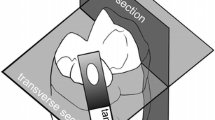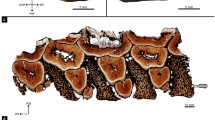Abstract
As description of enamel microstructure in mammals is mainly performed through 2D sections, interpretations of its formation and development can be misinterpreted by neglecting the complexity of its 3D arrangement. Through Simulenam, a novel software dedicated to the simulation of enamel prisms, and an updated, integrative model of decussation formation, we managed to transform 2D observations of enamel sections into full 3D representations of hippopotamoid enamel microstructure. This allowed us to reinterpret the 2D morphological characters of these taxa into geometric parameters and put a new light on how they evolved through time, with potential implications on their cellular origins – essential steps for furthering our understanding of enamel. Indeed, we also demonstrated that some of these characters could actually be non-homologous across taxa, and that there is at least two fundamentally different ways to produce enamel prism decussation in mammals.






Similar content being viewed by others
References
Alloing-Séguier L, Lihoreau F, Boisserie JR, Charruault AL, Orliac MJ, Tabuce R (2014) Enamel microstructure evolution in anthracotheres (Mammalia, Cetartiodactyla) and new insights on hippopotamoid phylogeny. Zool J Linn Soc 171:668–695
Arnason U, Gullberg A, Solweig G, Ursing B, Janke A (2000) The mitochondrial genome of the sperm whale and a new molecular reference for estimating eutherian divergence rate. J Mol Evol 50:569–578
Bartlett JD, Smith CE (2013). Modulation of cell-cell junctional complexes by matrix metalloproteinases. J Dent Res 92:10–17
Boisserie JR, Fisher RE, Lihoreau F, Weston EM (2011) Evolving between land and water: key questions on the emergence and history of the Hippopotamidae (Hippopotamoidea, Cetancodonta, Cetartiodactyla). Biol Rev 86:601–625
Boisserie JR, Lihoreau F, Brunet M (2005a) Origins of Hippopotamidae (Mammalia, Cetartiodactyla): towards resolution. Zool Scr 34:119–143
Boisserie JR, Lihoreau F, Brunet M (2005b) The position of Hippopotamidae within Cetartiodactyla. Proc Natl Acad Sci USA 102:1537–1541
Boyde A (1965) The structure of developing mammalian dental enamel. In: Stack MV, Fearnhead RW (eds) Tooth Enamel. John Wright and Sons, Bristol, pp 163–167
Boyde A (1969a) Correlation of ameloblast size with enamel prism pattern: use of scanning electron microscope to make surface area measurements. Z Zellforsch Mikrosk Anat 93:583–593
Boyde A (1969b) Electron microscopic observations relating to the nature and development of prism decussation in mammalian dental enamel. Bull Group Internatl Rech Sci Stomatol Odontol 12:151–207
Boyde A (1997) Microstructure of enamel. In: Chadwick DJ, Cardew G (eds) Dental Enamel (Ciba Foundation Symposium 205). Wiley, Chichester, pp 18–31
Gentry AW, Hooker JJ (1988) The phylogeny of the Artiodactyla. In: Benton MJ (ed) The Phylogeny and Classification of the Tetrapods, Volume 2: Mammals, vol. 35B. Systematics Association Special Volume. Clarendon Press, Oxford, pp 235–272
Hanaizumi Y (1992) Three-dimensional changes in direction and interrelationships among enamel prisms in the dog tooth. Arch Histol Cytol 55:539–550
Hanaizumi Y, Yokota R, Domon T, Wakita M, Kozawa Y (2010) The initial process of enamel prism arrangement and its relation to the hunter-Schreger bands in dog teeth. Arch Histol Cytol 73:23–36
Hunter J (1771) The Natural History of the Human Teeth. London
Jiang Y, Spears IR, Macho GA (2003) An investigation into fractured surfaces of enamel of modern human teeth: a combined SEM and computer visualisation study. Arch Oral Biol 48:449–457
Kallenbach E, Clermont Y, Leblond CP (1965) The cell web in the ameloblasts of the rat incisor. Anat Rec 153:55–70
Kalthoff DC (2000) Die Schmelzmikrostruktur in den Incisiven der hamsterartigen Nagetiere und anderer Myomorpha (Rodentia, Mammalia). Palaeontogr Abt A 259:1–193
Koenigswald, Wv (2004) Enamel microstructure of rodent molars, classification, and parallelisms, with a note on the systematic affiliation of the enigmatic Eocene rodent Protoptychus. J Mammal Evol 11:127–142
Koenigswald Wv, Martin T, Pfretzschner HU (1993) Phylogenetic interpretation of enamel structures in mammalian teeth: possibilities and problems. In: Szalay FS, Novacek MJ, McKenna MC (eds) Mammal Phylogeny, Placentals. Springer-Verlag, New York, pp 303–314
Koenigswald Wv, Sander PM (1997) Glossary of terms used for enamel microstructures. In: Koenigswald Wv, Sander PM (eds) Tooth Enamel Microstructure. Balkema, Rotterdam, pp 267–280
Lihoreau F, Boisserie JR, Manthi FK, Ducrocq S (2015) Hippos stem from the longest sequence of terrestrial cetartiodactyl evolution in Africa. Nat Commun 6: 6264
Line SRP, Novaes PD (2005) The development and evolution of mammalian enamel: structural and functional aspects. Braz J Morphol Sci 22:67–72
Maas MC (1993) A scanning electron-microscopic study of in vitro abrasion of mammalian tooth enamel under compressive loads. Arch Oral Biol 39:1–11
Macho GA, Jiang Y, Spears IR (2003) Enamel microstructure—a truly three-dimensional structure. J Hum Evol 45:81–90
Martin T (1993) Early rodent incisor enamel evolution: phylogenetic implications. J Mammal Evol 1:227–254
Martin T (1999) Phylogenetic implications of Glires (Eurymylidae, Mimotonidae, Rodentia, Lagomorpha) incisor enamel microstructure. Mitt Mus Nat kd Berl Zool Reihe 75:257–273
Martin T (2004) Evolution of incisor enamel microstructure in Lagomorpha. J Vertebr Paleontol 24:411–426
Mathur AK, Polly PD (2000) The evolution of enamel microstructure: how important is amelogenin? J Mammal Evol 7:23–42
Matthiessen ME, Møllgård K (1973) Cell junctions of the human enamel organ. Z Zellforsch Mikrosk Anat 146:69–81
Meng J, Wyss AR (1994) Enamel microstructure of Tribosphenomys (Mammalia, Glires): character analysis and systematic implications. J Mammal Evol 2:185–203
Nishikawa S (1992) Correlation of the arrangement pattern of enamel rods and secretory ameloblasts in pig and monkey teeth: a possible role of the terminal webs in ameloblast movement during secretion. Anat Rec 232:466–478
Nishikawa S, Fujiwara K, Kitamura H (1988) Formation of the tooth enamel rod pattern and the cytoskeletal organization in secretory ameloblasts of the rat incisor. Eur J Cell Biol 47:222–232
Nishikawa S, Tsukita S, Tsukita S, Sasa S (1990) Localization of adherens junction proteins along the possible sliding interface between secretory ameloblasts of the rat incisor. Cell Struct Funct 15:245–249
Osborn JW (1970a) The mechanism of ameloblast movement: a hypothesis. Calc Tiss Res 5:344–359
Osborn JW (1970b) The mechanism of prism formation in teeth: a hypothesis. Calc Tiss Res 5:115–132
Osborn JW (1990) A 3-dimensional model to describe the relation between prism directions, parazones and diazones, and the Hunter-Schreger bands in human tooth enamel. Arch Oral Biol 35:869–878
Pfretzschner HU (1993) Enamel microstructure in the phylogeny of the Equidae. J Vertebr Paleontol 13:342–349
Popowics TE, Rensberger JM, Herring SW (2004) Enamel microstructure and microstrain in the fracture of human and pig molar cusps. Arch Oral Biol 49:595–605
Reith EJ, Ross MH (1973) Morphological evidence for the presence of contractile elements in secretory ameloblasts of the rat. Arch Oral Biol 18:445–448
Rensberger JM (2000) Pathways to functional differentiation in mammalian enamel. In: Teaford MF, Smith MM, Ferguson MWJ (eds) Development, Function and Evolution of Teeth. Cambridge University Press, New York, pp 252–268
Rensberger JM, Koenigswald Wv (1980) Functional and phylogenetic interpretation of enamel microstructure in rhinoceroses. Paleobiology 6:477–495
Schreger BNG (1800) Beitrag zur Geschichte der Zahne. Beitrage für die Zergliederungskunst 1:1–7
Sehic A, Risnes S, Khan QES, Khuu C, Osmundsen H (2010) Gene expression and dental enamel structure in developing mouse incisor. Eur J Oral Sci 118:118–130
Shimizu D, Macho GA, Spears IR (2005) Effect of prism orientation and loading direction on contact stresses in prismatic enamel of primates: implications for interpreting wear patterns. Am J Phys Anthropol 126:427–434
Small JV (1989) Microfilament-based motility in non-muscle cells. Curr Opin Cell Biol 1:75–79
Smith CE, Warshawsky H (1977) Quantitative analysis of cell turnover in the enamel organ of the rat incisor. Evidence for ameloblast death immediately after enamel matrix secretion. Anat Rec 187:63–97
Stefen C (1999) Enamel microstructure of recent and fossil Canidae (Carnivora: Mammalia). J Vertebr Paleontol 19:576–587
Tabuce R, Delmer C, Gheerbrant E (2007) Evolution of the tooth enamel microstructure in the earliest proboscideans (Mammalia). Zool J Linn Soc 149:611–628
Tafforeau P, Zermeno JP, Smith TM (2012) Tracking cellular-level enamel growth and structure in 4D with synchrotron imaging. J Hum Evol 62:424–428
Ursing BM, Arnason U (1998) Analyses of mitochondrial genomes strongly support a hippopotamus-whale clade. Proc Roy Soc Lond B Bio 265:2251–2255
Vieytes EC, Morgan CC, Verzi DH (2007) Adaptive diversity of incisor enamel microstructure in south American burrowing rodents (family Ctenomyidae, Caviomorpha). J Anat 211:296–302
Waddell PJ, Okada N, Hasegawa M (1999) Towards resolving the interordinal relationships of placental mammals. Syst Biol 48:1–5
Warshawsky H, Smith CE (1971) A three-dimensional reconstruction of the rods in rat maxillary incisor enamel. Anat Rec 169:585–591
Xue H, Li Y, Everett ET, Ryan K, Peng L, Porecha R, Yan Y, Lucchese AM, Kuehl MA, Pugach MK, Bouchard J, Gibson CW (2013) Ameloblasts require active RhoA to generate normal dental enamel. Eur J Oral Sci 121:293–302
Yahyazadehfar M, Bajaj D, Arola DD (2013) Hidden contributions of the enamel rods on the fracture resistance of human teeth. Acta Biomater 9:4806–4814
Yuan X, Nishikawa S (2014) Angular distribution of cross-sectioned cell boundaries at the distal terminal web in differentiating preameloblasts, inner enamel secretory ameloblasts and outer enamel secretory ameloblasts. J Electron Microsc 63:33–39
Acknowledgments
The authors would like to thank the people who gave us access to the enamel samples used in this work: C. Sagne, Muséum National d’Histoire Naturelle, Paris; B. Marandat and L. Marivaux, Université de Montpellier; E. M’Bua and F. K. Manthi, National Museums of Kenya; and Y. Chaimanee, Department of Mineral Resources, Bangkok. We are grateful to S. Baghdiguian and R. Tabuce for useful discussions, and to C. Cazevielle, in charge of the Centre de Ressources en Imagerie Cellulaire (Montpellier). This project has been funded by the Research Council of the Université Montpellier 2, the Interrvie program of the INSU CNRS, the Revealing Hominid Origin Initiative program of the NSF, and is part of the ANR programs Palasiafrica (ANR-08-JCJC-0017) and SPLASH (ANR-15-CE32-0010-01). This is contribution #ISEM 2016-064 of the Institut des Sciences de l’Évolution de Montpellier (UMR5554-CNRS).
Author information
Authors and Affiliations
Corresponding author
Ethics declarations
Conflict of Interest
The authors declare that they have no conflict of interest.
Electronic supplementary material
ESM 1
(PDF 2129 kb)
Rights and permissions
About this article
Cite this article
Alloing-Séguier, L., Martinand-Mari, C., Barczi, JF. et al. Linking 2D Observations to 3D Modeling of Enamel Microstructure – a New Integrative Framework Applied to Hippopotamoidea Evolutionary History. J Mammal Evol 24, 221–231 (2017). https://doi.org/10.1007/s10914-016-9331-3
Published:
Issue Date:
DOI: https://doi.org/10.1007/s10914-016-9331-3




